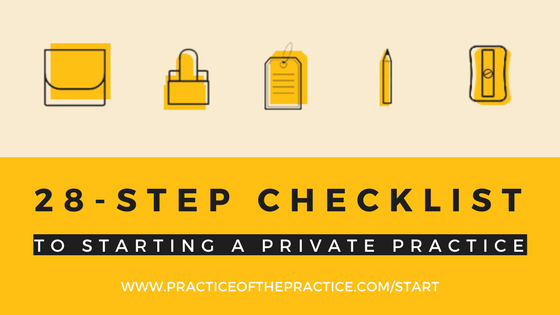Podcast: Play in new window | Download | Embed
In this episode, Joe Sanok speaks about how to create a marketing plan.
Podcast Sponsor
Confused by all the advice on starting a private practice? I’d love to help. I put together a checklist of the top 28 things to do to launch a private practice.
In This Podcast
Summary
If you are in private practice and are under the $60 000 mark, this podcast series is for you! Joe is going back to the basics and running through the various phases involved in setting up a practice that is going to thrive! In this episode, Joe speaks about how to create a marketing plan.
How To Create a Marketing Plan
Make sure to maintain a bigger vision when it comes to your marketing plan. Decide where you want your practice to go and how individual decisions will influence that. Structure your marketing plan over the next 12 months and break it up per quarter.
Start with what you want to achieve, i.e.: ideal income, etc., by the end of the year and work backwards from there. Set up KPIs (key performance indicators) for each quarter. Once you know what you need to achieve every quarter, break it down even further to goals per month and then per week.
“Learn to evaluate your overall use of time.”
Useful Links:
- 28-Step Checklist For Starting a Private Practice
- Systems to Grow a Practice: Marketing Plan, Flow, and Blogging | PoP 266
Meet Joe Sanok
Joe Sanok helps counselors to create thriving practices that are the envy of other counselors. He has helped counselors to grow their businesses by 50-500% and is proud of all the private practice owners that are growing their income, influence, and impact on the world. Click here to explore consulting with Joe.
Thanks For Listening!
Feel free to leave a comment below or share this podcast on social media by clicking on one of the social media links below! Alternatively, leave a review on iTunes and subscribe!
Podcast Transcription
File: PoP-267 How to Create a Marketing Plan
Duration: 0:08:59:15
[MUSIC]
Joe Sanok: This is the Practice of the Practice Podcast with Joe Sanok, session #267.
[MUSIC]
[INTRODUCTION]
Joe Sanok: Well, our series on starting a private practice continues today. I am Joe Sanok, your host here live in the radio center two building in beautiful and overcast downtown Traverse City. If you have never been to Traverse City, man, you’ve got to come here. It is awesome. It’s right on the water here, Northern Michigan. I should have them as a sponsor because I love living here so much and love when people visit me here. So if you are ever in Traverse City, let me know.
We are covering in this part of the Practice of the Practice Podcast part three of starting a practice. So in part one, we went through a whole bunch of things around the setup of a private practice. In part two, we went into attracting your ideal client, and then in part three we were talking about systems to grow. We covered in the last podcast all the wise systems that are important. Now, I know that, that [00:01:19.02] system is not super artsy, it’s not super flashy. But it’s so essential for you to grow and scale your practice. Later on when things are going well, when you got your ideal client, when you are just rocking it out, you don’t want to have a big old mess to deal with and undo and untangle. You want to try and do it right the first time or at least know what you are going to edit and change over time. And today we are covering the marketing plan.
[HOW TO CREATE A MARKETING PLAN]
Now, the marketing plan is one of the biggest things that people will come when we were doing consulting, when people are joining my Mastermind Group or other things that we support people with, with Practice of the Practice. They will want to create a marketing plan. And most marketing plans stink. They are a list of things to do. They don’t have a bigger picture. They don’t have a bigger direction. For me, I want to know where the practice is headed and how individual decisions fit into that. A lot of people make a five or ten year plan for their business. So much can change even in a year. You look at technology, you look at just your own life, like five years ago when I was 33… man, that was just, let’s see 5 years ago. I just launched Practice of the Practice. I was working full time at a community college and I had my side private practice kicking it out. What the heck! Like if I had said, in 5 years, I want to be doing all the stuff I am doing. Like, I didn’t have the vision for that. So I am not a huge fan on looking 5 years out. But what I am a big fan of is looking at the next 12 months. And then breaking that up per quarter. So say you want to by the end of 12 months from now have a practice that you could at least choose to leave a full-time job. Then we want to look at well, what kind of income do we need to have so that your family can feel good about that. Is that $30,000 a year, is that $60,000 a year, is that six figures, is that multi six figures? What does that look like? So we want to start with what’s the end? Like what do we want to achieve here within a year, and then I really like to work with people on what do we need to achieve in each quarter of the next 12 months. So in quarter one, two, three and four. So when we are looking at that bigger picture, we are not just going to say I want to build a e-mail list or we want to get more phone calls. We want to say we want to get more clients in here. We want to get more people coming in. We want to have the bottom line be 3 grand a week. We need to know those actual numbers instead of these kind of highfalutin things that don’t really matter. I want to have 500 people that like my Facebook page. If that doesn’t convert into anything that actually gives you more influence or income or impact, that’s just total waste of time. So we want to really look at what if we keep drilling into it, what we’re really trying to achieve here. And then our marketing comes out of that, out of that purpose, out of that impact on the world versus just kind of, “Oh, I guess I should run a Facebook ad.” Oh, I guess I should do this.
So we look at each quarter. We then say well, what would be a step towards that and goal within 12 months. And so it may be we need to get off insurance panel so we can charge more. It may be that we need it to launch our website or we need to rank higher in Google. And so then you keep working towards that and say if we achieved in quarter one, launching a website, blogging on a regular basis and ranking higher, and that was then helping us get more clients, what would that look like. So that would mean we need to get 10 calls a week so that we get five new intakes a week. Okay? Then we actually have some numbers to work with, some indicators, some key performance indicators. So then we want to look at quarter two, well, so that if that’s clicking along, say we achieved that in quarter one, then what would that look like next. Well, we need to get more people to the website because we know it’s working. And so it may be we are going to run some Facebook ads. We don’t want to pay more than, you know, $2 per click or $5 per click or $10 per click. We want to look at how much is that client worth. And then we want to keep looking at what else can we be doing. And so that could be submitting press releases to different magazines or newspapers or getting on the radio locally, so that you know every single quarter what you need to be doing.
Then once we have it sketched out in regards to each quarter, what you need to be doing, we want to then break it down per month and week. So that you have a really clear idea of specifically what you need to be working at for that bigger goal and what this does for you is it then helps you be able to set aside those things that don’t matter or that don’t matter as much as you think that busy works. So, checking your email every time something pings you, whenever you see that stupid little red dot on your phone. Turn that notification off and then say to yourself, okay, once a day, twice a day I am going to check my email at a key time or I am going to return phone calls during these key time instead of every single time something comes in. It’s going to distract me from the bigger thing that I am working on. So then we give ourselves permission for those things that take up energy, but are the best use of our energy to sit on the side. As well, we are also going to want to evaluate just our overall use of time. So for example, if you see 10 people week and each progress note takes you 3 minutes longer than it should, that 3 minutes is an extra 30 minutes a week you could be spending on something else. So we want to be looking at where those little places that we can kind of suck some extra time out of it, so that we can keep moving that needle forward with our practice. So when you do that, that’s going to help you fill out that marketing plan to know exactly each quarter what you need to be doing as well what you need to be doing week by week and then moment by moment with those micro goals that you are working on. And you are always going to have those [00:07:21.05] ways that you can market your practice and that you can get the word out. There’s tons more ways that we are going to be talking about marketing your practice and building systems, but when you do this, this system is going to then help you be able to scale and grow so much faster as you launch your counseling practice.
[CONCLUSION AND LINKS]
Thanks for letting me into your ears and into your brain. Next. we are going to be talking about following that flow from before someone lands on your website to scheduling an appointment to actually coming in and giving you money. Really excited about this part. Make sure if you aren’t getting the emails about starting a practice, then you head on over to www.practiceofthepractice.com/start. It will keep you from being confused and overwhelmed. You can stay organized and have a faster launch in the next 12 months. It’s totally free. You get a 28-step checklist that goes with it, 5-minute video on assessing local practices and knowing how you can outrank then. And then you are going to get phased out emails. So we’re going to give you clear action. We would love you to sign up over at www.practiceofthepractice.com/start. We will talk to you soon. Bye.
[MUSIC]
Special thanks to the band Silence is Sexy for intermusic, and this podcast is designed to provide accurate and authoritative information in regard to the subject matter covered. It’s given with the understanding that neither the host, the publisher or the guest are rendering any legal, accounting, clinical or other information. If you need a professional, you should find one.
[MUSIC]
[END OF PODCAST 00:08:59.14]



